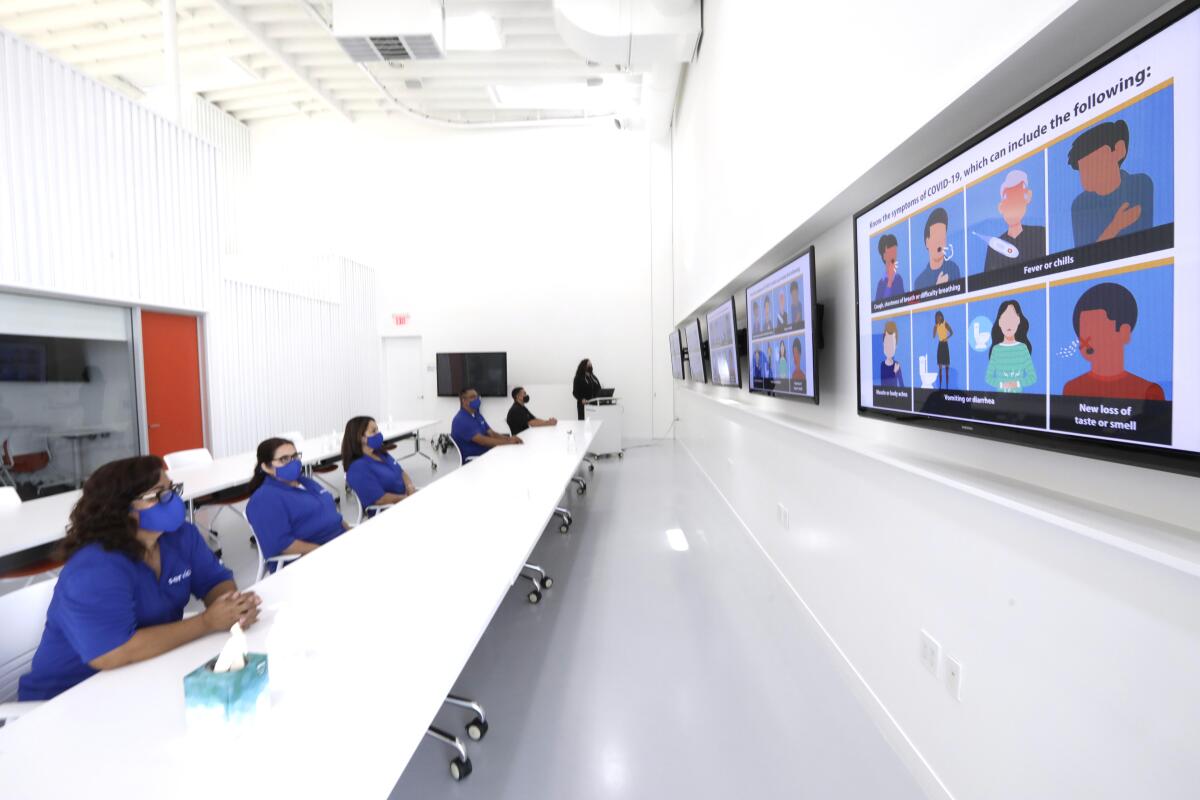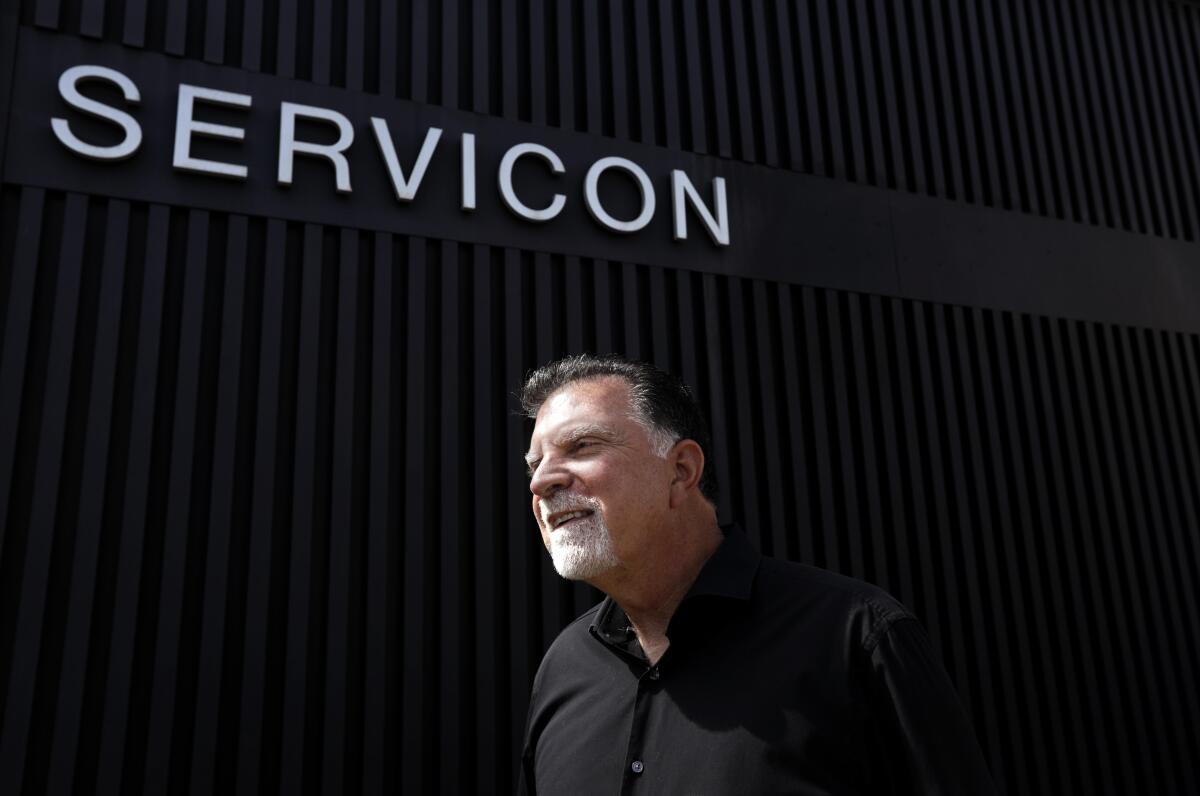California’s job growth tripled the nation’s, even as the Delta variant spread

California last month added jobs at three times the rate of the nation, as teachers returned to classrooms, entertainment venues reopened, and vacationers traveled despite a surge in COVID-19 infections.
Payroll jobs in the state grew in August by 104,300 to a total of 16.63 million, accounting for 44% of U.S. job growth, officials reported. At 0.6%, California’s monthly job growth was triple the 0.2% national pace.
The nation’s employment recovery was unexpectedly slow last month as vaccination rates in many states lagged behind that in California.
As of this week, two-thirds of California’s population is at least partially vaccinated against COVID-19. Nonetheless, with the coronavirus’ Delta variant continuing to spread and vaccine resistance persisting, the state’s recovery may remain uneven, economists said.
“California’s economy is now coping with larger concerns about the Delta variant than in the second week of August, when the jobs data was collected,” said Lynn Reaser, an economist with San Diego’s Point Loma Nazarene University. “The impact of school reopenings on infection rates and a weakening in consumer confidence could weigh on the near-term economic outlook.”
By last month, the Golden State had recovered just 62% of the 2.7 million jobs it lost in March and April 2020, when the pandemic took hold.
The state’s unemployment rate remains high, at 7.5%, a slight dip from July’s 7.6% but down significantly from 12.3% a year earlier. Nationwide, joblessness in August stood at 5.2%.
Many items destined for retailer shelves this holiday season are hopelessly snarled in the global supply chain. What does that mean for shoppers?
In California, “another full-scale economic shutdown is highly unlikely, but future economic growth could slow as long as the new virus remains a serious concern,” said Sung Won Sohn, a Loyola Marymount University economist. “The cloud cover has not gone away.”
Public schools accounted for 46,900 jobs last month, or nearly 45% of California’s net employment growth. “That’s likely a one-off gain that won’t be repeated,” said Scott Anderson, an economist with Bank of the West in San Francisco.
Apart from leisure and hospitality companies, which added 33,100 positions, hiring in other sectors was “quite anemic,” he said. “Supply chain bottlenecks, port backlogs and COVID fears are increasingly weighing on the California economic outlook.”
Business travel and tourism, linchpins of California’s economy, dried up beginning in March 2020. But this year, domestic leisure travel picked up, sports venues reopened and jobs began to return.

By midyear, about half of the 30,000 members of Unite Here Local 11, one of Southern California’s largest unions, had returned to work at hotels, stadiums, airport concessions and convention centers.
“We were feeling relatively positive before the Delta surge,” said Kurt Petersen, the union’s co-president. “But Delta has pulled us back, due to a stubborn group of people that refuses to be vaccinated.”
Convention centers remain dark, business groups are canceling reservations, international travel is all but nonexistent and tourism is not expected to fully bounce back for two years, he said. “Whole swaths of workers have not worked at all since March of 2020, and two-thirds of our members who have returned to jobs are given fewer hours than before the pandemic.”
Many hotel chains have cut automatic daily room-cleaning services, so housekeepers are working three days instead of five, Petersen said. “They can’t survive on that. And the jobs are harder, because a room that hasn’t been cleaned in days is often a pigsty.”
The recovery is likely to remain uneven. Professionals and technology workers who can operate from home have kept their jobs, as have workers classified as essential, such as grocery clerks and warehouse packers.
Although many employers report difficulties filling open jobs, California’s labor force grew by 55,300 workers in August and by 316,100 from a year earlier.
Before the program expired early this month, some 2.2 million Californians were receiving $300 a week in a federal government supplement to state unemployment insurance. A federal program offering jobless benefits to independent contractors who are not covered by state employment insurance, such as Uber and DoorDash drivers, also ended.
Some employers predict that the expiration of federal unemployment benefits could soon drive more people back to the workforce despite virus fears, a lack of child care, low wages or other factors that have kept them at home.
Servicon, a Culver City company that cleans hospitals, aerospace factories and office buildings throughout Southern California, has added 400 janitors since the beginning of the pandemic, bringing its total workforce to 2,000.

“The economy has its lurches, but we’re in demand,” Servicon Chairman Michael Mahdesian said. “After years of being told to be invisible, clients now want to see us disinfecting and cleaning. They want to give confidence to their employees that buildings are healthy.”
Mahdesian worries about the short-term effects of the Delta variant. “It is slowing down the recovery,” he said. “But California is better off than other states in getting people vaccinated. States like Texas and Florida are a mess.”
He applauds President Biden’s push for healthcare workers, government contractors and workers at large companies to be vaccinated. And he expects Congress to pass infrastructure bills that will get billions of dollars flowing to California and other states. “So I’m optimistic for the future,” he said.
Taner Osman, research manager at Los Angeles consultancy Beacon Economics, is also bullish. Since August, “two major head winds for the state’s economy have eased: the declining spread of COVID-19 cases and the reopening of schools,” he said. “This paves the way for strong job gains through the end of this year.”
About a month ago, L.A. County was averaging more than 3,400 new coronavirus infections a day. As of Tuesday, it was averaging fewer than 1,800 a day.
After public schools and leisure and hospitality businesses, the highest August job gains in California came in professional and business services (up 14,000) and “other services” (up 8,400), a miscellaneous group that includes auto repair companies and beauty salons.
The largest losses were in healthcare and social assistance (down 8,500) and state government (down 5,700).
August’s job report reflected the usual divide between Northern California’s tech-heavy economy, the Central Valley’s farm-dependent economy and Southern California’s service-reliant economy.
Unemployment was low in San Mateo County (4.6%), Santa Clara County (4.8%) and San Francisco County (5%). Joblessness in several inland regions was far higher than average: Kern County (10%), Tulare County (10.5%) and Imperial County (19.4%).
Los Angeles County added 55,700 jobs in August, for a total of 4.25 million. More than two-thirds were in public education. Motion picture and sound recording jobs grew by 6,000, reflecting a return to production by movie and television studios. The county’s unemployment rate dropped to 9.7% from 10.2% in July.
Orange County payrolls grew by 7,200 to 1.59 million, with public schools accounting for the full increase. Joblessness dropped to 6% from 6.3% in July.
In the Inland Empire, encompassing San Bernardino and Riverside counties, employment grew by 5,500 jobs to 1.52 million. Unemployment stood at 7.6%, down from 7.9% in July.
The state’s data come from a federal survey of 80,000 California businesses. The unemployment rate comes from a separate survey of 5,100 California households.
More to Read
Inside the business of entertainment
The Wide Shot brings you news, analysis and insights on everything from streaming wars to production — and what it all means for the future.
You may occasionally receive promotional content from the Los Angeles Times.













